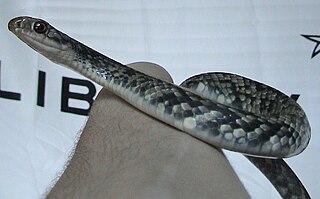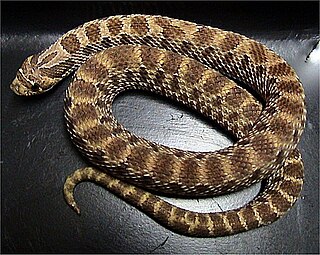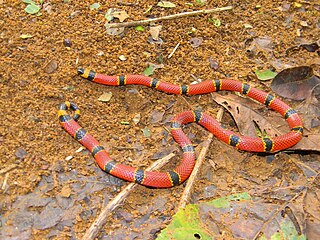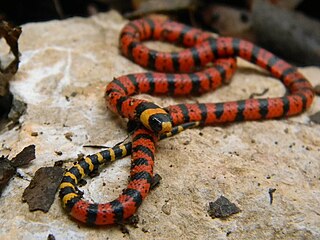
Trimeresurus stejnegeri is a species of venomous pit viper endemic to Asia. Two subspecies are currently recognized, including the nominate subspecies described here.

Pseudoxenodon macrops, commonly known as the large-eyed bamboo snake or the big-eyed bamboo snake, is a species of mildly venomous rear-fanged snake endemic to Asia.

The eastern racer, or North American racer, is a species of nonvenomous snake in the family Colubridae. The species is endemic to North America and Central America. Eleven subspecies, including the nominotypical subspecies, are recognized, which as a group are commonly referred to as the eastern racers. The species is monotypic in the genus Coluber.

Karl Patterson Schmidt was an American herpetologist.

The western hognose snake is a species of snake in the family Colubridae. The species is endemic to North America. There are three subspecies that are recognized as being valid, including the nominotypical subspecies.

The peach-throated monitor, also known as the Sepik monitor, is a species of monitor lizard native to New Guinea.

Thamnophis proximus, commonly known as the western ribbon snake or western ribbonsnake, is a species of garter snake in the subfamily Natricinae of the family Colubridae. The species is found in the central and southern United States, Mexico, and Central America south to central Costa Rica. The species has six recognized subspecies.

Ninia sebae, commonly known as the redback coffee snake or the red coffee snake, is a species of small terrestrial snake in the family Colubridae. The species is native to southeastern Mexico and Central America south to Costa Rica. Although it resembles some venomous coral snakes in color and size, it is not venomous and seldom bites humans.

Micrurus nigrocinctus, commonly known as the Central American coral snake, is a species of a highly venomous snake in the family Elapidae. The species is endemic to Latin America from southern Mexico, Central America, to north Colombia. There are six recognized subspecies, including the nominate subspecies described here.
Schmidt's blind snake is a species of snake in the family Typhlopidae. The species is endemic to Central and Southern Africa.

Senticolis is a genus of nonvenomous snake in the family Colubridae. The genus Senticolis is monotypic, containing the sole species Senticolis triaspis, also known as the green rat snake. The species is endemic to Central America, Mexico, southern Arizona, and southern New Mexico.

Micrurus browni, commonly known as Brown's coral snake, is a species of venomous snake in the family Elapidae. The species is native to Guatemala and southwestern Mexico. There are three recognized subspecies, including the nominate subspecies described here.

The elegant coral snake is a species of elapid snake, native to southern Mexico and Guatemala. There are two recognized subspecies.

Micrurus diastema, commonly known as the variable coral snake, is a species of venomous snake in the family Elapidae. The species is endemic to southeastern Mexico and northern Central America. There are seven recognized subspecies.

Micruroides is a genus of venomous coral snake in the family Elapidae. The genus is monotypic, containing only the species Micruroides euryxanthus.

Pseudoxenodon is a genus of snakes in the subfamily Pseudoxenodontinae of the family Colubridae. Species in the genus Pseudoxenodon are native to Southeast Asia.

The large-eyed green tree snake, also known commonly as the splendid dagger-tooth tree snake, is a species of venomous snake in the subfamily Colubrinae of the family Colubridae. The species is endemic to Africa. There are three recognized subspecies.
Pope's keelback is a species of snake in the family Colubridae. The species is found in Vietnam and southern China.

The dull bamboo snake, also known commonly as the Javanese false cobra, is a species of snake in the subfamily Pseudoxenodontidae of the family Colubridae. The species is endemic to Indonesia. There are three recognized subspecies.

Pseudoxenodon stejnegeri, commonly known as Stejneger's bamboo snake or (Stejneger's) mountain keelback, is a species of snake in the family Colubridae. The species was first described from Taiwan where it is widespread. It is also widespread in eastern China and has also been recorded in Yunnan and Hunan. There are two subspecies:

















